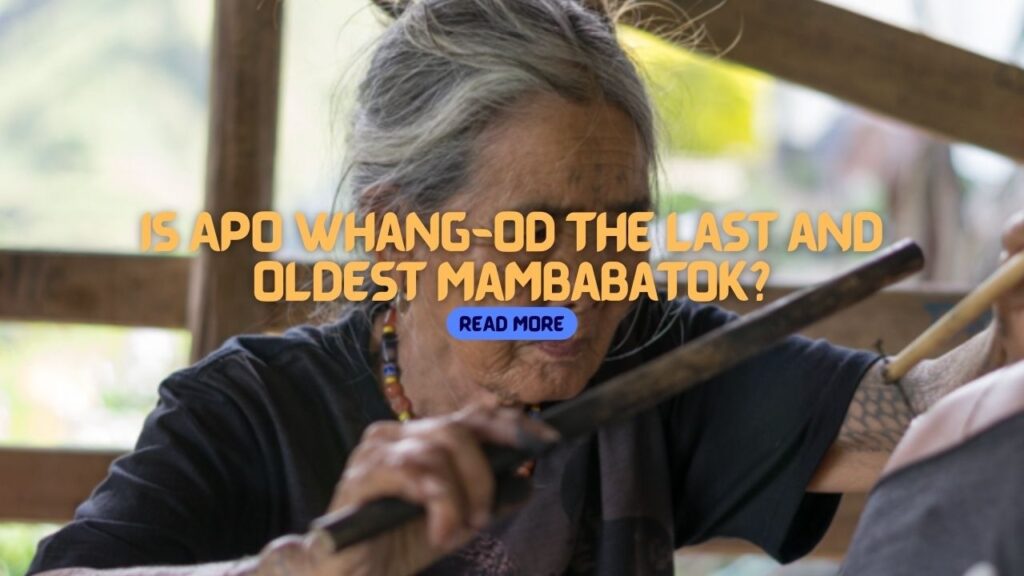Is Apo Whang-od really the last and oldest Mambabatok?
11 min read
Is Apo Whang-od Truly the Last and Oldest Mambabatok? Examining the Legacy
Apo Whang-Od, at over a century old, stands as a living legend in the world of traditional tattooing in the Philippines. Considered by many as the oldest and possibly the last Mambabatok of the Kalinga ethnic group, she represents a bridge between the ancient practice of ‘batok’ and its modern admirers. ‘Mambabatok,’ means tattoo artist in Kalinga culture.
For generations, this title has been bestowed upon those who intricately ink the skin of tribe members with designs steeped in history and personal significance.
Despite the common perception that Apo Whang-Od is the last of her kind, there is an open-endedness to the lineage of Mambabatok. The traditional Kalinga tattooing, or ‘batok,’ is experiencing a revival, with younger practitioners being trained in the age-old techniques.
These newcomers are adopting the role of cultural preservationists, ensuring that the heritage of inking, deeply entwined with identity and community, will survive. As such, while Apo Whang-Od’s prominence cannot be understated, the claim of her being the last Mambabatok is met with nuances that point to a broader, continuing narrative of this cultural icon’s impact.
The Historical Context of Mambabatok
The practice of mambabatok, a traditional tattooing technique, emanates from the Kalinga province in the Philippines and has been intertwined with the province’s identity and culture for centuries. It is characterized by its unique methods, which include the use of thorns and bamboo sticks, tapping into the skin to embed natural inks made from coal and water.
Kalinga Tribe and Batok
Kalinga, home to the Kalinga tribe, is renowned for its intricate, hand-tapped tattoos known as batok. This form of traditional tattoo represents a variety of societal roles, including beauty, strength, and protection. The tribe’s warriors were especially recognized by these tattoos, indicating their skill and status within the tribe.
Traditionally, a mix of charcoal and water was used to create the ink, and the tattoos were applied using a thorn affixed to a bamboo stick, a testament to the resourcefulness of the indigenous peoples.
Batok transcended mere ornamentation, it became an integral part of cultural heritage and tradition, each design replete with symbols significant to the Kalinga tribe.
Apo Whang-Od: The Mambabatok Legend
Apo Whang-Od, a member of the ButBut tribe in Kalinga, has been deemed one of the national living treasures or Gawad sa Manlilikha ng Bayan. At over a century old, she is often referred to as the oldest mambabatok and has dedicated her life to the practice of Kalinga tattooist artistry.
Her expertise and commitment to the tradition have made her a cultural icon, not only within the Ifugao and Bontoc communities but also across the Philippines.
Apo Whang-Od’s legacy is instrumental in the preservation of the Kalinga’s cultural heritage, ensuring that these time-honored techniques continue to signify the tribe’s rich history and stories of its people. Through her hands, the tradition of batok persists, and its cultural significance is imparted upon each generation, transcending the mere act of tattooing to embody the spirit of an entire culture.

How old is Apo Whang-od?
Apo Whang-od is believed to have been born in 1917, making her around 107 years old as of 2024. However, due to the lack of birth documentation, there are questions about this claim. Therefore, the claim of being the oldest mambabatok is also in question.
Is Apo Whang-od the last Mambabatok?
Apo Whang-od, known as the eminent mambabatok of her time, is hailed for her remarkable skills in traditional Kalinga tattooing. While some may label her as the last of her kind, she remains dedicated to passing down this ancient art to ensure the enduring legacy of the mambabatok tradition.
The Controversy
Apo Whang-Od, also known as Whang-Od Oggay, is a well-known figure in the Philippines, celebrated for her traditional tattooing skills. She is often referred to as the “oldest mambabatok” or traditional Kalinga tattooist. The title “mambabatok” is specific to the Kalinga ethnic group and refers to the traditional tattoo artists who use a distinct hand-tapping technique. As of the information available, Whang-Od turned [107 years old in February], which contributes to claims of her being the oldest living mambabatok.
On February 13th, a Facebook user, Michael Gambican Umaming, sparked intrigue with a mysterious post delving into the journey to find facts about Whang-Od. He openly pondered the veracity of details surrounding the famed tattoo artist, focusing on her age.
This curiosity emerged in the wake of Whang-Od’s recent high-profile moment alongside President Bongbong Marcos and Juan Ponce Enrile, where she was honored with the prestigious Presidential Medal of Merit in recognition of her profound influence on Filipino culture and craftsmanship.
If there are discrepancies pointed out by a Filipino on Facebook regarding her claim as the ‘oldest mambabatok,’ it would be important to consider the specific nature of those discrepancies. Such claims might refer to the possibility of other elder mambabatoks existing within the Kalinga community or could be questioning the accuracy of her age. However, without specific details on the discrepancies mentioned, it’s challenging to address them directly.
Whang-Od’s reputation and recognition, including features in prominent publications like [Vogue], suggest that her status as a significant cultural figure is widely acknowledged. It’s also worth noting that titles like “the oldest” can sometimes be symbolic or honorary, recognizing her contributions and lifetime commitment to the art of Kalinga tattooing rather than being a strictly factual claim about her age relative to all other practitioners.

Understanding the Batok Tradition
The ancient Filipino tradition of batok is a tattooing technique deeply embedded in the cultural heritage of the Kalinga people. This art form is not only a matter of aesthetics but also signifies one’s role and status within the community.
Technique and Tools of Batok
Batok tattoos are applied using a thorn from the calamansi or pomelo tree, which serves as the needle for the procedure. The thorn is attached to a bamboo stick, and then tapped into the skin with a second bamboo stick. A mixture of coal and water—sometimes augmented with sugar cane juice—is used as ink.
This method is labor-intensive and requires precision, symbolizing strength and endurance both for the tattoo artist and the recipient.
Cultural Significance of Tattoos
In Kalinga culture, tattoos (batok) serve as multifaceted symbols. They are considered marks of beauty, signifiers of fertility, badges of protection during war, and indicators of one’s ability to contribute to the well-being of the community.
Each tattoo contains motifs and symbols that tell a story or highlight an individual’s accomplishments. The significance of these tattoos is so profound that they are regarded as integral parts of one’s identity and social stature within the fabric of Kalinga culture.
Apo Whang-Od’s Influence and Legacy
Apo Whang-Od, also known as Maria Oggay, has cemented a deeply influential legacy as both a symbol of cultural preservation and a herald of Filipino tradition to a global audience. This centenarian’s dedication to the mambabatok, the traditional Kalinga tattoo art, has inspired countless individuals while spurring dialogues on cultural representation and continuity.
Global Recognition and Cultural Impact
Apo Whang-Od’s artistry as a traditional Kalinga tattooist has attained worldwide recognition, as evidenced by features in major publications like Vogue. Her unique position in the global tapestry of indigenous arts has raised awareness about the importance of safeguarding such cultural practices from potential cultural appropriation.
This renown has not only brought pride to Filipino people but also ignited a global conversation on the importance of cultural preservation.
Apprenticeship and Transmission of Skills
At over 100 years old, Apo Whang-Od has ensured the survival of the mambabatok tradition by passing on her skills to her grand-nieces and other apprentices like Grace Palicas.
These proteges play a critical role in the preservation of the Mambabatok art, as they embody the next generation’s link to the heritage of the Kalinga people.
By teaching others, Apo Whang-Od acts as a bridge between past and future, ensuring her indelible mark on Filipino culture persists.
The Role of Tourism in Buscalan
Tourism in Buscalan, Kalinga, has surged due to the notoriety of its traditional tattoo industry, largely driven by the reputation of Apo Whang-Od, and has become a significant contributor to the local economy.
Buscalan as a Destination for Tattoo Enthusiasts
Buscalan Village has carved out a unique niche in the tourism map, attracting visitors from all over the globe. These tourists, often tattoo enthusiasts, travel to Buscalan seeking the authentic hand-tapped tattoos that are a hallmark of the Kalinga tradition.
The presence of Apo Whang-Od, often cited as the oldest and last Mambabatok (traditional tattoo artist), has turned the village into a pilgrimage site for this ancient art form.
The practice of hand-tapped tattooing is not only a sight to behold but also an experiential slice of the Kalinga culture offered to visitors.
Impact of Tourism on Local Community and Tradition
The influx of tourists to Buscalan has had a considerable impact on the local community and the preservation of their traditions.
While tourism has introduced an alternate industry providing jobs and revenue that bolster the local economy, it also brings challenges to the resilience of local customs.
There is a delicate balance to maintain the integrity of Kalinga tattooing while accommodating the economic benefits tourists bring.
Guides, accommodations, and other tourism-related services in Tinglayan and Tabuk have expanded, reflecting the growing significance of tourism in the regional socio-economic landscape.
Present and Future of Traditional Tattooing
While Apo Whang-Od has become a pivotal figure in the tradition of Kalinga tattooing, the craft extends beyond her story to encompass modern adaptations and controversies surrounding cultural preservation. Implications for the future involve both challenges and the continuing safeguarding of this intangible cultural heritage.
Modern Practitioners and Adaptations
The ancient practice of hand-tapped tattooing, mastered by Apo Whang-Od and other Mambabatok, continues to inspire modern tattooists both in the Philippines and globally.
These practitioners fuse traditional motifs with the use of modern tattoo machines, expanding the reach and evolution of traditional tattoo artistry.
For instance, celebrities like Aiza Seguerra and Liza Dino have highlighted the relevance of these indigenous practices today, representing their enduring connection to Filipino culture.
Challenges and Controversies
Despite the rising interest in traditional tattoos, concerns over cultural appropriation and the exploitation of indigenous practices remain prevalent.
Buscalan, the village where Apo Whang-Od resides, experiences a substantial flux of tourists seeking authentic tribal tattoos, which raises questions about the commodification of cultural heritage.
Moreover, the resilience of this art form must counter the narrative that it might vanish with its oldest practitioners.
Safeguarding Intangible Cultural Heritage
Efforts to protect and pass on the legacy of traditional tattooing as a cultural heritage are underway.
Indigenous tattooists carry on Mambabatok practices, ensuring this art form persists through generations.
These endeavors are not only about preserving the technique but also about maintaining the stories, values, and representation intrinsic to the cultural identity they embody.
Emerging Faces in the Batok Scene
The batok tradition, while rooted in its ancient past, is seeing a resurgence in interest and practice.
New practitioners within this art form are stepping forward, ensuring the techniques and cultural significance of mambabatok are not lost to the sands of time.
Younger Generations Embracing Batok
In the wake of Apo Whang-Od, a new wave of Filipino artists are rising to take batok beyond its traditional borders.
These emerging mambabatok are not only embracing the art for its beautification purposes but are also keen on preserving their indigenous heritage.
Among them, young women have been especially notable for their role in this cultural revival.
They are coming forward as apprentices, learning under the guidance of seasoned practitioners, and are deeply engaged in the novation and transmission of skills that define this age-old craft.
Grace Palicas and the Future of Mambabatok
Grace Palicas, a prominent figure in the next generation of mambabatok, carries the legacy of her mentor and great-aunt, Apo Whang-Od.
She has become particularly well-known among both locals and tourists, not only for her tattooing skills but also for being a custodian of the Butbut people’s traditions.
Trained under the watchful eye of Apo Whang-Od herself, Grace represents a living bloodline continuing the batok practice.
This apprentice to the master has stepped out to be a symbol of hope and continuity for Filipino cultural identity, much like a young tree growing strong under the sheltering branches of a venerable pomelo tree.
Her rise is also symbolic of the broader acceptance and recognition of indigenous art forms, perhaps inspired by legal measures such as the Centenarians Act of 2016 or Republic Act 10868, aimed at honoring and sustaining the cultural contributions of elder Filipinos.

Frequently Asked Questions
Apo Whang-od is renowned for her traditional Kalinga tattooing, perpetuating an ancient art form and serving as a cultural beacon. These questions delve into her significance, contributions, and impact within the sphere of traditional Filipino tattooing.
What is the significance of Apo Whang-od in the tradition of Kalinga tattooing?
Apo Whang-od stands as a living legend in Kalinga tattooing, a tradition she inherited and continues to practice even at her advanced age.
She embodies the Kalinga people’s deep-rooted cultural identity and the artistry of their traditional body art.
How has Apo Whang-od contributed to the cultural heritage of the Butbut people?
Through her lifelong dedication to the craft, Apo Whang-od has been instrumental in preserving the traditional tattooing techniques of the Butbut tribe.
She has shared her knowledge with younger generations, helping to ensure that this part of their cultural heritage is not lost.
What is the role of Apo Whang-od in preserving the art of Mambabatok?
As arguably the most recognized practitioner of the Mambabatok art form, Apo Whang-od plays a crucial role in preserving the traditional methods of Kalinga tattooing.
Her practice and teaching have maintained the continuity of this cultural tattooing technique.
At what age did Apo Whang-od start learning the craft of traditional tattooing?
Apo Whang-od began learning the art of Mambabatok from her father as a young girl.
She has spent the better part of a century perfecting the craft, thereby earning her place as the oldest living tattooist in the Philippines.
How is Apo Whang-od’s approach to tattooing different from modern techniques?
Unlike modern tattooing techniques that rely on electric machines and synthetic inks, Apo Whang-od’s approach is grounded in the use of natural materials like charcoal and water for ink, and thorns from the calamansi tree as needles—a method steeped in tradition and practiced for generations.
What impact has Apo Whang-od’s recognition had on the community of Kalinga tattoo artists?
Since gaining fame, Apo Whang-od’s recognition has shone a light on the Kalinga community. This has attracted global interest in their tattooing tradition.
This has increased opportunities for the local economy and the next generation of traditional tattoo artists. It ensures the art’s survival into the future.
Follow and Subscribe to OutofTownBlog.com on Facebook, Twitter, Instagram, and Pinterest, and Team Out Of Town on YouTube for more travel-related updates.
Read:





